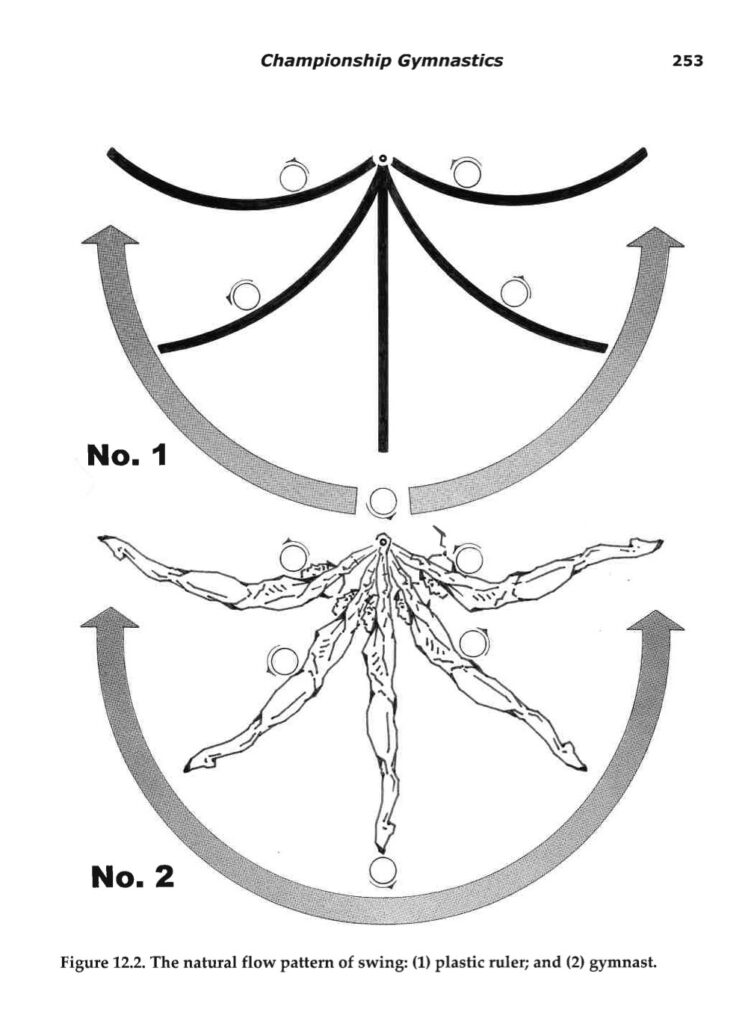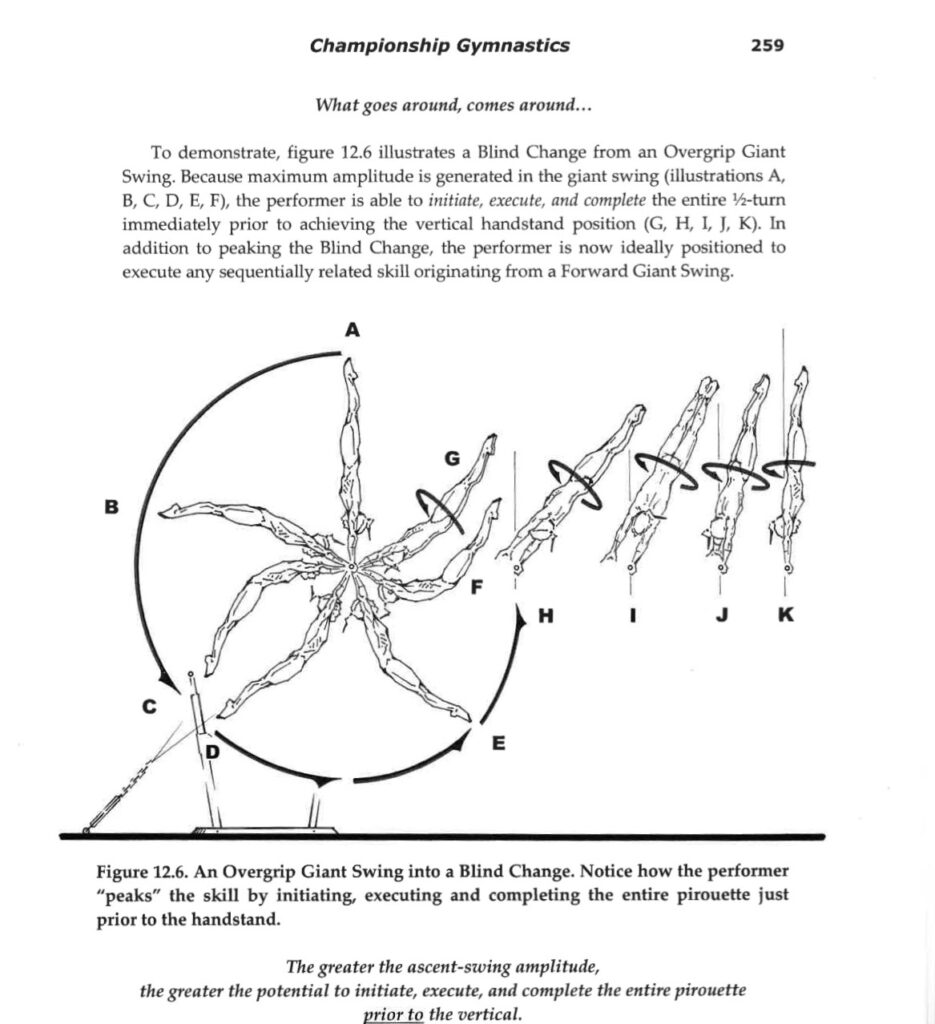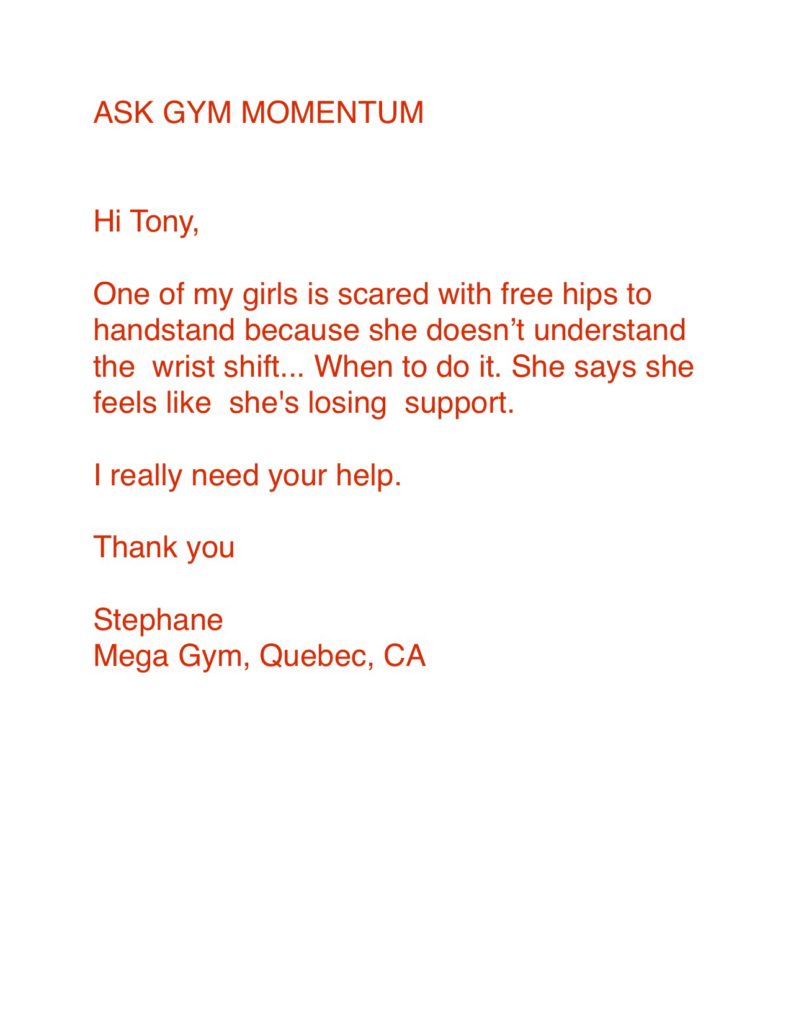Video of Strap Bar Lecture. Presented at various gymnastics workshops 2025
Alberta Gymnastics Federation High Performance Camp.
Alberta Gymnastics Federation High Performance Camp. November 2024

In order to get the most out of our time together I wanted to give my plan for the weekend and my expectations.
UNEVEN BARS PLAN, EXPECTATIONS, and RESOURCES.
EXPECTATIONS for Training Camp:
I would like All levels to be able to show me at least 1/2 routine (1st 1/2, 2nd 1/2). It is OK if parts are spotted. Please be ready to AT LEAST show me combinations. We have a lot of ground to cover.
For example: The following are IN ROUTINE not individual skills.
Level 8/9 show an upgraded dismount. Can be spotted or into pit.
Level 9 show an upgraded release move. Can (should) be spotted. For example- 1st 1/2 routine with shoot over or Pak (spotted ). 2nd 1/2 with upgraded dismount (spotted or pit)
Level 10 same as level 9
Example Routine: these are JUST examples.
Example: Level 8.
- Kip cast 1/2 pirouette.
- Clear hip handstand.
- Kip cast toe circle around bar. Jump down.
Go over pit
- Kip Cast Hand
- Giant, Giant
- Double tuck. (upgraded dismount)
Example: Level 9
From outside bar-
- Jump to high bar
- Kip Cast handstand
- Clear hip Handstand
- Pak (spotted)
- Kip cast Handstand.
Middle section
- Kip Cast handstand (from inside bar)
- Toe handstand 1/2 pirouette
- Toe shoot to high bar.
Go over pit
- Kip cast Hand
- Giant 1/2
- Front giant 1/2
- Open double tuck. Etc.
What has made me successful at the National and International level is having a plan. Both LONG and SHORT term planning as well as designing a practice schedule to be efficient and have the gymnasts prepared for competition.
LONG TERM PLAN, 4+ years. What skills will a gymnast need to be able to compete at the next Olympic Games.
SHORT TERM PLAN, What skills will a gymnast need to be able to compete this season.
PRACTICE PLAN, This is more specific to your gym as well as individual gymnasts. How many hours do you have to train a day? A week? How much or a work load can your gymnast handle physically? Mentally and emotionally?
Tony’s 10 commandments for Bars.
- NEVER be out of Routine shape.
- Have your dismount FIRST. Maybe a year before the routine.
- Master the Basics then hit them every day.
- Strap Bar is an event.
- Pick the right skill for the right kid. (a gymnast who has fear of back tumbling on floor is probably NOT going to be a Tkatchev kid)
- HANDSTANDS- everywhere, every day.
- Don’t paint yourself in to a corner. (ie. you do not teach a back flyaway, you teach a front and double front- if the double front gets devalued or a gymnast has a growth spurt and now has trouble with the front swing- what do you do?)
- Introduce them to every skill they may need by 13 years old.
- Have a plan and a back up plan
- Let them play.
Every skill of value starts with a great basic circling element. In a race to put together a routine we have a tendency to chase the skill before we have established a truly great base element.
- Clear hip.
- Toe handstand. (front and back)
- Stalder. (Legs together and straddle) (front and back)
- Giants Back and Front.
What ever the base skill is for your goal element you MUST be able to do 4-5 in a row consistently. Do it first on STRAP BAR
I will continue to add to this until the day of the clinic so you may want to check back for additional resources.
Some thoughts from my plane ride in. Updated November 6. 2024
My plan for uneven bars is that the gymnast needs to be 1+ season ahead for their dismount. Because it comes at the end of their routine there is a certain amount of endurance they need. They will already be fatigued from their routine, they should just be able to let muscle memory takeover.
You must have a truly great base if you are going to build on it. All circles start on strap bar. Progress to 3-5 in a row.
Then they must be able to do 3-5 in a row on the bar before you add to it (adding a pirouette or a release).
While they are perfecting circles we are doing tramp/ TT drills for releases and pirouettes.
Things to remember-
Teach them to throw and catch.
Teach the body shape early. Continue to reinforce them. Teach them how to use them.
1. Hect action skills
- Tkatchev (giant)
- Ray (toe hand)
- Hindorf (clear hip)
- Ricna (stalder)
Shaposhnikova
Maloney
2. Jaeger
3. Gienger
I tend to teach 1 and 2 at the same time because they share some actions. #1 has so many uses and can be done either way. The Jaeger is great because it covers the requirement for undergrip skill and can be taught in either under or “L” grip.
Prerequisite will always be a GREAT base skill. 3-5 x in a row.
OPEN skills teach from a swing. It forces the correct tap and then when you want to use it in combination it is already there.
Group 1 (Hect)
Stage 1
- Back extension roll hop.
- TT Bar Hop
- Straddle roll grab
Stage 2
- Back Extension Roll off mat kick back (almost a bridge)
- Back drop to stomach drop (straight)
Stage 3
- Base skill to hop
- TT bar flight to back
- Back drop to stomach drop (Straight) catch noodle
- Jump Back off bar catch
Stage 4
- With flight over bar no catch
Group 2 (Jaeger)
Stage 1
- Forward roll to handstand undergrip
- Stomach drop with TT bar
- Pike or straddle roll grab
Stage 2
- Forward roll to HS in undergrip Hop change
- Sushinova off beam or mat to floor
- Front layout sit up on bounce handstand
- Stomach drop on TT bar hop off.
Stage 3
- Gainer front off TT into pit
- Front kaboom on tramp (3/4 layout. Sit up)
- Back drop front pike tramp
- Jump Back off bar catch
Stage 4
- Spotted Front giant with release to straight. Eyes on bar
- Front Kaboom sit up and catch noodle
- Front layout sit up catch noodle on Bounce HS
- Front 1.25 on tramp
Stage 5
- Spotted jaeger from swing. (Grip doesn’t matter)
Group 3
Stage 1
- Layout flyaway from swing
- Leaf drop
Stage 2
- Layout flyaway to back from swing
- Leaf drop 1/4
- Layout on tramp jump 1/4
- Cruise on Tramp
Stage 3
- Continue with layout flyaway from swing
- Leaf drop 1/4 catch noodle
- Gainer off tramp or TT
- Cruise on tramp catch noodle
- Back kaboom
Stage 4
- If you have a trench bar- Layout flyaway to stand on side of pit
- Gainer w/ 1/4 twist off tramp or TT reach back
- Kaboom layout 1.25 to stomach. Catch noodle.
Lecture Videos and Slides Italy Master Clinic
Presentazioni delle lezioni per l’Italia Master Workshop.
Developing a Plan for Uneven Bars
Be A Better Coach
Combination Tumbling
Yurchenko Vaulting- Go BIG
Drills for Front Giants and Blind Changes
My friend Bryon Hough texted me last week looking for drills for side stations for FRONT GIANTS and BLIND CHANGES. After I sent him a few I started thinking about the importance of side station drills in a gymnastics program.
What is the purpose of them? What are you trying to accomplish?
My rule of thumb is that side stations and drills are for the skills we need to have NEXT season or maybe even possibly the season after that. If I have to drill for the skills that are currently in their routine I am in trouble.
Specifically for BARS, which is how this whole thing started. I treat their current routine as their warm up. We then work problem parts and more routines (during the season). Always trying to leave a few minutes for upgrade skills that may get into routines. Obviously NOT when we are in the championship part of the season (March-Nationals).
Typically it will be your LEVEL 7 and/or 8s who are working drills for FRONT GIANTS and BLIND CHANGES. Here is my approach.
- Get comfortable in UNDER GRIP.
- Push up in under grip
- Handstands in under grip
- Handstand walking on floor in under grip
- Hanging on Bar and tap swings in under grip
- Bounce HS in under grip
2. Get comfortable with a basic pirouette
- One arm handstands on floor bar
- Pirouetting out of under grip
- Hanging pirouettes
- Blind changes. Start in handstand. Progress to blind change INTO handstand
3. Swinging in under grip and understanding the front giant whip tap
- Front flyaway from under grip. (Always good to know how to do if they rip off bar)
- Hanging tap swing
- Progressively larger tap swings with front giant tap. 1st in over grip. Then in under grip. Do this OVER PIT or spotted. They will rip off the bar!
- Strap Bar tap swings.

4. Strap Bar work. I think the safest place to teach a gymnast to swing for front giant is in strap bar. They can be aggressive and really work the correct tap without fear of ripping off. For ease of entry (we do a whole routine on strap bar) we do everything in over grip.
- Progressively larger front giant tap swings.
- 3-5 front giants in a row
- Also incorporate front in bar skills
5. Grip shift on low bar.
- Mill Circle
- Seat circle
- Toe on around bar
6. Tramp and Tumbl Trak
- Front bounder on tumbl trak or tramp. The hollow – arch action is similar to the front giant.
2. progress to front layout. Then do front layout holding a pool noodle in under grip.
3. Front kaboom to handstand. Progress to kaboom to 1/2 front layout.
4. On TT bar front drop to handstand.
I cannot stress enough the importance of being able to FRONT GIANT prior to attempting blind change or Jaeger. The gymnast needs to be comfortable with the front giant before you have them pirouette into it OR have them do a release move from it. Even if they NEVER compete it, they should be at least able to do it on a single rail. If your plan is for them to do a full pirouette, and they don’t make it, they better know how to do something in under grip- even if it is just how to hold on for dear life.
Blind Change Drills. I have written a previous article on Pirouetting. You can see it HERE
- Handstand walking sideways on floor bar or beam
- One arm handstands
- Pirouette with partner
- Hang on Bar pirouette
- TT bar bounce HS walk
- TT Bar bounce hand stand 1/4 pirouette
- Giant swing walking
- Layout 1/2 on Tramp

USING YOUR STRAP BAR. 2019 USAG National Congress Lecture
Ask Gym Momentum- Conditioning Exercises For Bars
Uneven Bars is possibly the most challenging event. It is different that the other events for girls. A Cartwheel learned on Floor Ex transitions to a Round off and aerial. The can be used at Floor, Vault and Beam. Bars is just different and takes, obviously, a great deal of upper body strength.
My general rules for conditioning:
- Tell the girls what they are conditioning for so that they understand the connection.
- Strength the Shape
- Move through the Shape
- Add Speed as they move through
- Teach them the skill that the shape is for.
- ALWAYS monitor conditioning.
- Have strength related goals
- Have Strength related prerequisites (for example- 8 pull ups before they can giant.)
The Core Strength you are doing for other events is probably sufficient for bars.
Bars takes grips strength and endurance. Rope climb is pretty great at this. Think, 12- 15 skills in an optional bar routine. They should be able to do 12-15 pulls with each arm on the rope. Strengthen the handstand, the handstand shape as well as moving IN and OUT of a handstands. The strength from 1/2 leg lifts will give them the strength needed to hold feet up after skills on low bar.
I feel Press Handstands are very necessary to be a good bar worker. A gymnast needs to be able to lift their body upside down to a handstand on every circling skill.
Spot MILLIONS of cast handstands. There is no way around this. Sorry.
This is only a small list. I hope it helps!
Have a Question?
ASK GYM MOMENTUM. tony@gymmomentum.com
Ask Gym Momentum- Answer. WRIST SHIFT ON CLEAR HIP/ FREE HIP CIRCLE

Stephene- Here are some drills that we do on a regular basis. We start off with working on the strength of shoulder and core. Then we progress to circling elements. Many different kinds! Just to help the gymnast get comfortable with the shift.
There is one drill that I didn’t have time to video. My apologies. It is 3-5 free hip circles in a row. SPOTTED. Each one getting a little bigger than the previous one.
If we were to do 3 in a row it would go:
- horizontal
- 3/4
- Handstand
I hope that helps!
Tony
Do you have a question you want answered on Video? Send your question to Tony@gymmomentum.com
Release Moves Lecture 2017
This is a video of my Release Moves Lectures. Because of it’s size I had to divide it into 2 Parts.
Part 2
Any Questions or comments feel free to reach out to me.
Tony
Toe on Toe off Handstand. Drills and Progressions
Toe on toe off to handstand is a skill nearly every gymnast should have in their repertoire.
Perhaps it is my own teaching style or the progressions I use but I have found toe on toe off a little easier than clear hip circle. If I have 10 gymnasts I can probably get 8 of them to clear hip handstand. Of that 8, 2 of them will do it well.
With a Toe on Handstand, I can still get 8 out of 10 to do toe on handstand but at least 6 can do it well.
Since all circling skills on bars should start and end in handstands, at the beginning and the end the hips will be (for example) 2.5 feet from the bar. During the circle, the hips only come in slightly.
Another benefit of the toe on handstand is that it is easier to transition to other in bar circling skills like stalders.
- Always make sure they know what a handstand feels like.
- Shape the body then work through that shape. (pike rolls with and without Forester Bar)
- Pike presses off floor bar
- Pike Bounce handstands on Tumbl Trak
- Back extension rolls with and with out Forester Bar
- Back Extension roll pike landing
- From Floor Bar Handstand pike down to bar
- Jump Toe circle dismount
- Cast Toe circle dismount
- Cast Toe circle around bar
- Jump Toe circle around bar (then press back to mat)
- Continue with increasing height.
- use of strap bar
Handstand Drill
“The very symbol of the sport, the handstand, is indeed one of the most important fundamental elements in gymnastics. Although often viewed as an individual skill, the handstand shape is repeatedly seen in every event, every exercise, and virtually every movement sequence.” Dr Gerald S. George, Ph.D. “Championship Gymnastics. Biomechanical Techniques For Shaping Winners” 2010 [Read more…]